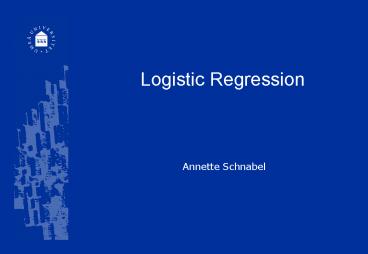Bild 1 PowerPoint PPT Presentation
1 / 20
Title: Bild 1
1
Logistic Regression
Annette Schnabel
2
1. OLS-Regression (trust in others - yes or no?)
3
Prediction
4
- Problem For bivariate dependent variables, OLS
leads to wrong predictions! - Mathematically there are as well three good
reasons not to use an OLS-model - The linear function leads to predictions outside
the possible range of the dependent variable
(0-1). - OLS requires that the error-term is uncorrelated
with the predictors. For a bivariate dependent
variable the error terms are not independent from
the predictor. - The error-term is inherently heteroskedastic.
5
How to cope with the problems?
- AIMS
- We want to limit the range of possible
predictions - We want to keep a linear model.
6
Step 1 Probability function
- Understanding the bivariate dependent variable Y
in terms of probabilities - The probability to find a trustful person among
all persons questioned - Pn (trustful)/n(all) ? P 38879/42150 0,9224.
- What is the role of the independent variable
here? - Independent variables improve our guess whether a
person we pick randomly will be trustful or not.
Theses variables provide the conditions of the
probability - P(Y1) under the condition that x1,2,3,...,n
- P(Y1x)
- Probabilities cannot exceed the 0,1-boundary
- ? Y is understood as P and P is bounded between
0 and 1.
7
Graphically
linear
Y
1
logistic
turning point
½
0
X
8
Mathematically
9
Step 2 Linearizing the model
- Yab1x1b2x2b3x3e
- If we want to write the right-hand side of the
equation as an additive function of the
predictors we have to transform the dependent
variable.
10
What does THAT mean?
- "log" refers to the natural logarithm
- the term (P/(1-P)) refers to the ODDS, that is
the ratio of probabilities. - The odds for the current example are
- P(Y1)/1-P(Y1) 38879/3271 11,89
- Individuals are 12 times as likely to be trustful
than to not be trustful
11
CONCLUSION SO FAR
- A logarithmic function solves the problem of an
upper and a lower bound and a different shape of
the function needed to predict more correctly - But This results in a pretty complicated model
of independent variables. - To keep the an additive model we have to
transform the dependent variable. - With help of the logic of logarithm, we transform
the dependent variable into log odds and by this
are able to keep an additive model on the
right-hand side of the equation.
12
And so does the logistic regression model looks
like
13
ODDS
- Example Sexual intercourse among teens
ODDS
ODDS RATIOS
Probabilities
14
Logistic regression
- Example Sexual intercourse among teens
Probabilities
15
How does a Logistic regression looks like?
Example Voting Behaviour
Probability P(Y1) ? 31420/423590,741745
16
Omnibus Tests of Model Coefficients
Model Summary
Classification Table
17
Variables in the Equation
18
Omnibus Tests of Model Coefficients
.Model Summary
Classification Table
19
Variables in the Equation
20
Thank you!

